

Toraja
Pg 1
A Fascinating Sojourn In The Lost World – Tana Toraja In South Sulawesi
A. Introduction
The sojourn in Tana Toraja was a side trip in our diving expedition to Raja Ampat. Three couples, Chris and wife Esther, Simon and wife Kim and me and wife Lucy flew to Makassar, the capital of South Sulawesi, on 29 July. We explored Tana Toraja led by a Tour Guide, Matius in a van driven by Nur.

Amongst the six travelers, only Esther and Lucy did not continue the journey to Raja Ampat.
B. Brief Itinerary
30/07/2011 – Road journey from Makassar to Toraja and stay in Missiliana Hotel in our sojourn in Tana Toraja.
31/07/2011 – Visit Bolu Market, old stone graves at Marante Village and traditional Toraja village in Ketekesu.
01/08/2011 – Visit Palawa, Sadan Deri, Batu Tunonga, Lokomata, Pana and Tikala.
02/08/2011 – Visit Lemo, Baby graves in Sangalla and Londa.
03/08/2011 – Return to Makassar.
C. A Brief History,Culture and Life In Toraja
C1. General
Tana Toraja is located in south Sulawesi. It is the third main tourist destination in Indonesia after Bali and Borobudur.

Map of South Sulawesi
Toraja means people who live in the highlands. Toraja ancestors came from Cambodia and Indo China over 20 centuries ago. The migrants crossed the ocean by wooden boats. When they arrived on the west cost of Sulawesi, they made their way up the Saddang River and stopped in a place which is now known as Enrekang, about 230km north of Makassar, the capital of South Sulawesi. The steepness of Saddang River upward from Enrekang forced them to leave their boats behind. They moved on northward in groups and settled down on the banks of Saddang River. They hung their boats on cliffs and lived in them.
As the group grew, rivalry among them became unavoidable. So some moved northward and formed new communities. The various groups from the east, south and southeast came in frequent contacts with highlanders; they named the place “To-Raja” to mean people from the northern highland. The word finally became Toraja. And the Buginese people called the area Tana Toraja.

Map of Tana Toraja
As the community expanded, it needed a place for social and council activities. The place built for such activities was known as Tongkonan.

The most significant ritual practice by Torajans is the location of all their houses and structures. They are built in accordance with the cardinal points. North is considered the head of the sphere, south is the buttock, and east represents good “Fong Shui” while the west denotes dead or sadness.
The indigenous religion is based on an animistic belief and was slightly influenced by Hinduism and Confucianism long before Christianity. The latter was introduced by the Dutch colonial government in the early 1900s. The last religion to be introduced was Islam. However, nowadays many people in Tana Toraja are still adhering to old customs and culture. And also the followers of all religions are peacefully leaving together in the fertile highland.
The main crops are rice (white, brown and black), coffee (Arabica) and cloves. Other crops are sweet potatoes and maize which are consumed by the villagers with little vegetation, chickens, eggs and fish.
C2. Fumeral Ceremony
There are several important ceremonies in the Tojaran community. The most unique culture still in practice is the funeral ceremony. The higher the status of the dead the more elaborate and longer the ceremony is. It can last for seven days or more.
The funeral ceremony is a unique ritual intended to celebrate the soul of the dead ascending to heaven. It is usually very extravagant, colorful and spectacular. It is no longer a mournful time – it is a feast!
The dead body is traditionally kept in the house with the family for various lengths of time until the family can afford to hold the ceremony. The corpse may have to be kept in the house for months or even years until the family has saved enough money and supplies, like buffaloes and pigs, for the occasion.
The funeral ceremony is also an occasion for the reunion of the family and for relatives, neighbors and all friends in the village or nearby villages to congregate and join in to respect the deceased.
For the performance of the ceremony, small bamboo sheds are installed in the special location in the centre of the village dedicated for the ceremony to accommodate the gusts. All attending the ceremonies put on black clothes as a symbol of mourning.
Buffaloes and pigs are slaughtered and food and drinks are served to all present. During the ceremony, traditional dances and songs are performed and also during the slaughtering of animals.
The more buffaloes are sacrificed, the more prestigious is the ceremony. Each family from the clans contributes at least one buffalo. A family who has received a favor in the form of a buffalo is to return at least the same number when the need arises. The most prestigious and valuable buffalo is the spotted one with white spots and stripes. This spotted one can be ten times more expensive than the black ones.
After the ceremony is over, the corpse is taken to a designated grave in the stone or cave for burial. When this is done he/she is considered to be officially DEAD!
 |
 |
The graves, according to the Torajan belief is the only change from the real world to the unseen one and the dead bodies should be well looked after by the families in safe places in stiff cliffs on high mountains.
Except for some Christians and Muslims, the remains of the dead bodies are kept in graves above ground. There are different types of graves where the dead are buried:
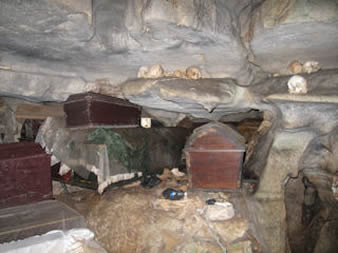 |
 |
Graves in Stone Caves Gaves Dug in Rock
 |
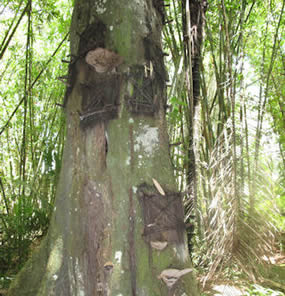 |
Hanging Graves in Steep Cliff |
Baby Graves in Trees |
C3. Tongkonan
Tongkonan is a place or house where originally heads of families in the village discuss all social affairs and problems relating to religion and welfare. It now also functions as an ancestral house of a clan or living quarters of the head of local government.
Tongkonan are built in groups of 5 to 7 units with rice barns in front acting as “wives” of the traditional houses.
The architecture is similar to the boats that carried their ancestors from Indo China and Cambodia. Because there was no place to live in, the new settlers converted some of the boats into living quarters.
The roofs rise up at both ends like the bow and stern of a boat representing heaven. The control post links the house to the earth. The roof is described as the buffalo horn which has a prestigious meaning – never been beaten in any war!
No nails are used in the construction of a Tongkonan and it can be moved as a whole from one place to another. The front of the Tongkanan is covered with traditional intricate carvings painted with four sacred colors; black, yellow, red and white.
The Tongkonan also symbolizes the status of its owner. The size, the elaborate decoration and the number of buffalo horns displayed on the central post in front indicate the status of the families. The more horns it has the more prosperous is the owner.
 |
 |
The uniqueness of Toraja culture, the shape of their ancestor house, Tongkonan, the sacred carvings and stone graves are all unique and fascinating. Also the funeral ceremonies, the hanging graves and baby graves in trees are only found in Torajaland.
D. Road Journey To And Fro From Makassar To Rantepao
Six of us left LCCT by Air Asia in the afternoon (2pm) of 29 July and arrived at Makassar Airport in the evening (5pm). We were met by our Guide from Wira Tours, Matius and the van driver, Nur. We were transferred to Hotel Horizon in Makassar.
Next morning we left Makassar for Rantepao in a van. The journey was only 328 km but it took more than nine hours to reach our destination. The coastal road from Makassar to Pare-Pare was under repair and reconstruction from a two-lane road to a 4-lane highway. All vehicles in both directions had to slow down frequently at many locations where reconstruction was being carried out. It is rather unusual to reconstruct road in short stretches, each less than 1/2km in distance all along the road of about 100km long. Also at sections where culverts or other structures are to be built, they were left unattended.
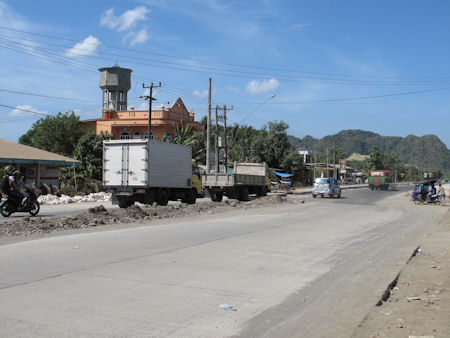
We arrived at Pare-Pare, the second port of South Sulawesi situated about halfway between Makassar and Rantepao at about noon and had our lunch in a restaurant with a panoramic view of the town and the Makassar Straits.
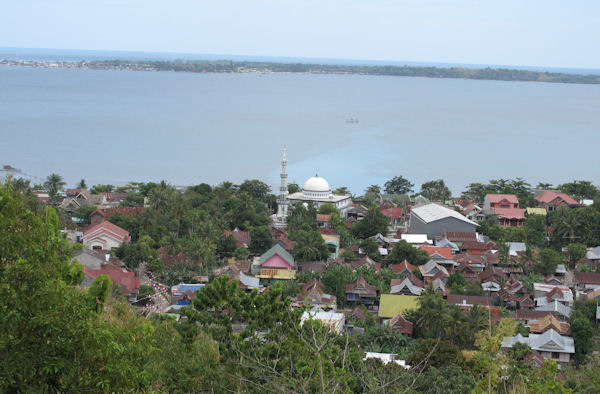
From Pare-Pare, we left the coastal road and went inland to Rappang. From Rappang we proceeded north to Enrekang through narrow mountainous roads. We stopped for refreshment in a shop near Enrekang and from there we had a panoramic view of an erotic mountain.

The mountainous road continued from Enrekang and at around 5pm we arrived at Tondon, a small town near Makale, the entry into the district of Tana Toraja.

We arrived at our destination, Rangtepao about 7pm and checked into Hotel Missiliana where we stayed for four nights in our sojourn in Toraja.
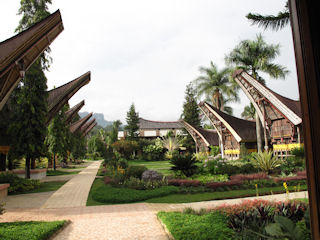 |
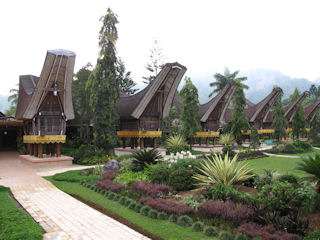 |
The big compound in Missiliana hotel complex
After completing our tour of Toraja, we returned to Makassar via the same route. However at Maros, 30km north of Makassar, we turned off from the main road towards a small village, Bantimurung to see the famous waterfall.
 |
 |
In the park besides the waterfall there were numerous butterflies flying around. The park has been referred to as a butterfly museum.
Along the journey, we passed by many villages and paddy fields.
 |
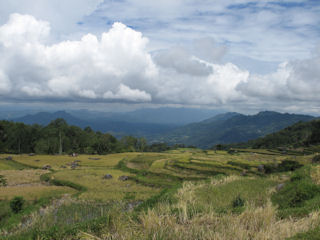 |
Back to Home Pg Pg 1 Pg 2